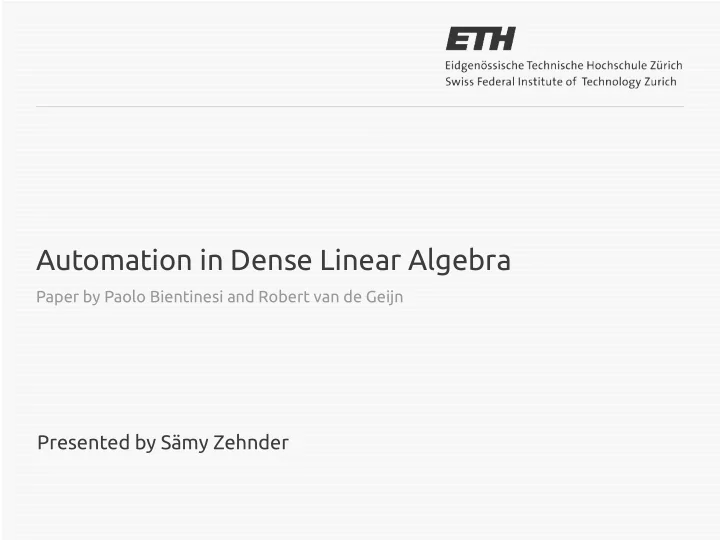

Automation in Dense Linear Algebra Paper by Paolo Bientinesi and Robert van de Geijn Presented by Sämy Zehnder
Content Motivation Building a new algorithm Prototype Conclusion 2
Motivation ● Best algorithm for a dense linear algebra problem? ● LU ● Cholesky ● Eigenvalues ● SVD ● ... ● Highly used for: ● Interpolation of functions ● Solving systems of equations ● Optimization 3
Idea: Automatically build it! X Y Problem http://www.aices.rwth-aachen.de:8080/~pauldj/pubs/CC-2009.pdf 4
Content Motivation Building a new algorithm Prototype Conclusion 5
Steps needed X Y Γ(X) PME Loop-invariant Loop Code 6
Layout of the algorithm 7
PME L-Inv. Loop Code Γ(X) Example: Cholesky factorization Cholesky A L Γ(A) = L ● How do we compute L, so that A = LL T ? 8
PME L-Inv. Loop Code Γ(X) Problem to PME T A = L L Γ( A )= L 9
PME L-Inv. Loop Code Γ(X) Problem to PME T A = L L Γ( A )= L 10
PME L-Inv. Loop Code Γ(X) Problem to PME T A = L L Γ( A )= L 11
PME L-Inv. Loop Code Γ(X) Problem to PME T A = L L Γ( A )= L 12
PME L-Inv. Loop Code Γ(X) Problem to PME 13
PME L-Inv. Loop Code Γ(X) Loop-invariant ● Holds before, at the begin and after the loop 14
PME L-Inv. Loop Code Γ(X) Loop-invariant ● Holds before, at the begin and after the loop 15
PME L-Inv. Loop Code Γ(X) Choosing a Loop-invariant ● Any subset of the PME ● Some blocks can be 0x0-matrices ● Has to respect the dependencies http://www.aices.rwth-aachen.de:8080/~pauldj/pubs/CC-2009.pdf 16
PME L-Inv. Loop Code Γ(X) Choosing a Loop-invariant 17
PME L-Inv. Loop Code Γ(X) Choosing a Loop-invariant ● At the beginning: 18
PME L-Inv. Loop Code Γ(X) Choosing a Loop-invariant ● At the beginning: ● At the end: 19
PME L-Inv. Loop Code Γ(X) Ensuring progress 20
PME L-Inv. Loop Code Γ(X) Construction of the loop 21
PME L-Inv. Loop Code Γ(X) Construction of the loop PME: 22
PME L-Inv. Loop Code Γ(X) Construction of the loop PME: 23
PME L-Inv. Loop Code Γ(X) Recap 1. Building the PME 2. Choosing the Loop-Invariant 3. Construction of the loop ● Repartioning ● Computation of one step 24
PME L-Inv. Loop Code Γ(X) Recap 1. Building the PME 2. Choosing the Loop-Invariant 3. Construction of the loop ● Repartioning ● Computation of one step 25
PME L-Inv. Loop Code Γ(X) Recap 1. Building the PME 2. Choosing the Loop-Invariant 3. Construction of the loop ● Repartioning ● Computation of one step 26
PME L-Inv. Loop Code Γ(X) Recap 1. Building the PME 2. Choosing the Loop-Invariant 3. Construction of the loop ● Repartioning ● Computation of one step 27
Content Motivation Building a new algorithm Prototype Conclusion 28
PME L-Inv. Loop Code Γ(X) Prototype system ● Takes loop-invariant, returns loop-algorithm ● Generates worksheet, Matlab- or C-code ● More than 300 algorithms for the Level-3 BLAS library ● Found 50 algorithms for the triangular coupled Sylvester equation (3 previously known) 29
PME L-Inv. Loop Code Γ(X) Prototype system function [A] = choleskyL1( A , nb ) [ ATL, ATR, ... ABL, ABR ] = FLA_Part_2x2( A,0,0,’FLA_TL’); %% Loop Invariant %% ATL=choleskyL[ATL] %% ABL’=0 %% ABL=ABL %% ABR=ABR while( size(ATL,1) ~= size(A,1) | size(ATL,2) ~= size(A,2) ) b = min( nb, min( size(ABR,1), size(ABR,2) )); [ A00, A01, A02, ... A10, A11, A12, ... A20, A21, A22 ] = FLA_Repart_2x2_to_3x3(ATL, ATR,... ABL, ABR,... b, b, ’FLA_BR’); %* *********************************************************** *% A10 = A10 . inv(A00)’; A11 = choleskyL(A11 - A10 . A10’); %* *********************************************************** *% [ ATL, ATR, ... ABL, ABR ] = FLA_Cont_with_3x3_to_2x2(A00, A01, A02, ... A10, A11, A12, ... A20, A21, A22, ’FLA_TL’); end; return ATL; 30 http://www.aices.rwth-aachen.de:8080/~pauldj/pubs/CC-2009.pdf
Content Motivation Building a new algorithm Prototype Conclusion 31
Conclusion + Problem description (A = LL T ) sufficient for automatic algorithm generation + Possible to generate proof of correctness side by side with generation of algorithm + Performance: Familiy of algorithms => autotune these - Numerical stability is not ensured. Proof for every algorithm needed. http://kaichido.com/wp-content/uploads/2010/10/Fotolia_733842_XS-Balance-scale1.jpg 32
Thank you! Are there any questions? 33
Recommend
More recommend